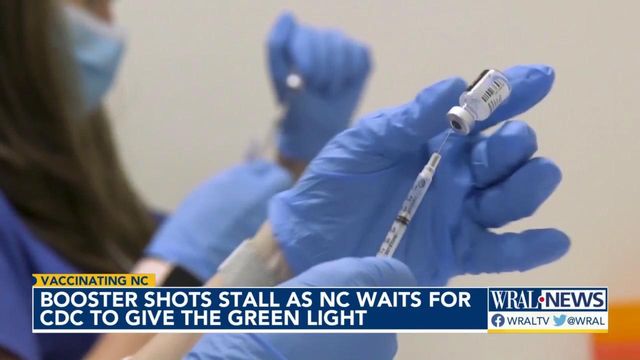COVID-19 booster shots could get final OK on Thursday
Scientific advisers to the Centers for Disease Control and Prevention met on Wednesday to begin to decide which Americans should get booster shots of the Pfizer-BioNTech coronavirus vaccine -- and when.
Posted — UpdatedScientific advisers to the Centers for Disease Control and Prevention met on Wednesday to begin to decide which Americans should get booster shots of the Pfizer-BioNTech coronavirus vaccine — and when.
On Thursday, advisers to the CDC will try to be more specific about who qualifies. Depending on the verdict, booster shots could be offered to most Americans, or only to a select few.
The CDC committee’s recommendations are influential but not binding, and state officials sometimes implement their own criteria. In any event, the advice will come too late for the Biden administration, which had planned to begin offering third doses this week to most fully vaccinated adults in the United States.
On Wednesday, the committee zeroed in on unanswered questions in the data available so far.
A third dose undoubtedly amps up antibody levels, the experts said. But it’s unclear how long that increase lasts, whether it translates to a meaningful boost in protection against severe disease, and whether it can significantly decrease transmission of the virus. Scientists on the committee also noted the paucity of safety data, especially among younger people.
Several advisers said they believed the goal of the boosters should be to prevent severe illness, hospitalization and death, rather than infection.
“I would just encourage us not to lump infection and hospitalization,” said Dr. Sarah Long, a pediatric infectious disease expert at Drexel University College of Medicine in Philadelphia. “I don’t think there’s any hope that vaccines such as the ones we have will prevent infection after the first, maybe couple weeks that you have those extraordinary immediate responses.”
The advisers also wrestled with the practicalities of endorsing a booster shot of the Pfizer vaccine, but not of the Moderna or Johnson & Johnson vaccines. Such a recommendation might leave people who initially were immunized with the latter two vaccines feeling unprotected.
“That’s a big public health panic that we would like to avoid,” Long said.
Some experts seemed to suggest that if regulatory rules would not permit them to recommend mixing the different types of vaccines, they might delay recommending booster shots altogether until people who got the Moderna shots could also receive boosters.
Moderna asked the FDA this month to authorize a half dose of its vaccine as a booster shot. Federal regulators are reviewing Moderna’s data to determine whether it supports the authorization.
Earlier in the day, the advisers heard detailed evidence about the different types of immunity induced by the vaccines. Natalie Thornburg, a CDC scientist, presented results from a series of studies suggesting that declining levels of antibodies may have little effect on protection from severe illness. Some subsets of antibodies are needed to prevent infection, but immune cells that prevent the illness from progressing are stable, she said.
“Antibodies decrease over time as we expected, in all age groups, but cellular memory is maintained,” she said. Immunity is known to drop off in adults over 80, however, suggesting that boosters may be needed for that age group. And one CDC study showed a drop in the ability of the vaccines to prevent severe disease in adults over 65.
Boosters can reduce cases among nursing home residents, who are among those at highest risk, according to results from a modeling study described at the meeting. But even with highly effective boosters, cases in nursing homes will persist when community transmission is high, said Rachel Slayton, a CDC scientist who presented the model.
Vaccinating staff at nursing homes, and other prevention strategies to limit transmission, will continue to be important, she said.
Some global health experts have criticized the Biden administration for pushing booster shots when much of the world’s population is yet to receive a first dose. But on Wednesday, Jen Psaki, the White House press secretary, reiterated the administration’s argument that it was possible to offer boosters to Americans while vaccinating the rest of the world at the same time.
On Wednesday morning, President Joe Biden said that the United States would buy and donate 500 million doses of the Pfizer-BioNTech vaccine, adding to the 500 million the administration purchased in July.
“We’re now donating three shots globally for every one shot we put in the arm of an American, and our view continues to be that we can do both and it’s a false choice,” Psaki said. “Our view also continues to be that frankly the rest of the world needs to step up and do more.”
At the meeting of FDA advisers on Friday, senior scientists at Pfizer and the Israeli Ministry of Health presented data they said indicated waning immunity in people who received the Pfizer vaccine months earlier. Boosting immune defenses with a third shot has made a difference in Israel, they said, and could stem the tide of infections in the United States.
The FDA advisers also evaluated data from the CDC on the trajectory of the virus in the United States, as well as summaries from several studies on the effectiveness of the vaccines.
But after reviewing the evidence, the scientists on the committee concluded that while protection against infection may be waning, especially in older adults, the original two-shot regimen still offers excellent protection against severe illness and hospitalization in most people.
Related Topics
Copyright 2024 New York Times News Service. All rights reserved.






